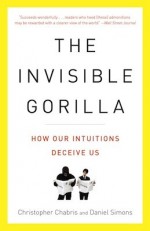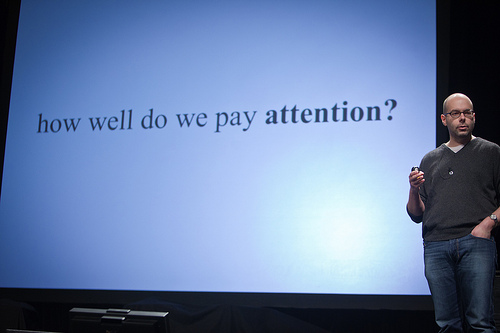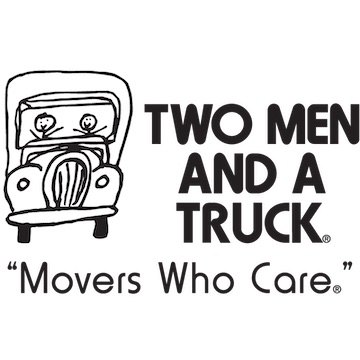Why Cyclists Get Hit

 I’m reading Daniel Simons’ and Christopher Chabris’ book Invisible Gorilla. You’ve probably seen their video as it is one of the best-known modern experiments in psychology and a YouTube sensation with over 11 million hits. It shows two teams of three students passing basketballs. As a test, viewers are asked to silently count the number of passes of one team while ignoring the passes of the other. Most people get the right answer but half of the people do not see a gorilla walk into the middle of the group, turn and face the camera for 9 seconds, beat its chest, and walk off. How is this possible? What made the gorilla invisible?
I’m reading Daniel Simons’ and Christopher Chabris’ book Invisible Gorilla. You’ve probably seen their video as it is one of the best-known modern experiments in psychology and a YouTube sensation with over 11 million hits. It shows two teams of three students passing basketballs. As a test, viewers are asked to silently count the number of passes of one team while ignoring the passes of the other. Most people get the right answer but half of the people do not see a gorilla walk into the middle of the group, turn and face the camera for 9 seconds, beat its chest, and walk off. How is this possible? What made the gorilla invisible?
This error of perception comes from lack of attention to an unexpected object. “When people devote their attention to a particular area or aspect of their visual world, they tend not to notice unexpected objects, even when those unexpected objects are salient, potentially important, and appear right where they are looking.” This phenomenon, called “inattentional blindness,” is not why Simons and Chabris wrote the book. Rather, it was the surprise people showed when they realized what they had missed.
I’ve seen this look of surprise many times from my bicycle. It happens most often at intersections where cars are waiting to turn into or across my lane. Drivers are expecting to see fast, bulky, 2,000 pound objects and miss me, a slow, relatively slender, 200 pound object. That is they miss me until I wave or shout a greeting or change my line or speed. Then I get a startled look of chagrin that reveals an awakening to what British cyclists call SMIDSY – Sorry, mate, I didn’t see you.
There are three other important takeaways for bikers from Invisible Gorilla. First, wearing bright colors and reflective clothing makes it easier for you to be seen by drivers who are looking for you but does not resolve the looking-but-failing-to-see problem. Simons further tested selective attention using a red gorilla suit, and Steve Most, now a professor at the University of Delaware, created a computerized version of the gorilla experiment substituting a red cross moving through a black-and-white setting. Making the unexpected object as distinctive as possible still yielded a 30% failure rate.

Invisible Gorilla co-author Chris Chabris
Second, we do not multi-task well. In a second part of the original gorilla experiment, the observation tasks were made more difficult by asking the participants to keep two separate mental counts, one of bounce passes and one of aerial passes. As predicted, the number of people who missed the unexpected event increased by 20%. Simons finds this closely analogous to drivers using cell phones. Having the phone removed from the ear by legislating hands-free calling does nothing to improve our attention – it’s the attention to the call itself that impairs our attention. “The more attention-demanding tasks your brain does, the worse it does each one.”
Third, Simons asserts that there is one proven way to eliminate inattentional blindness: make the unexpected object or event less unexpected. “Walking and biking were the least dangerous in the cities where they were done the most, and the most dangerous where they were done the least.”
More bicyclists make the streets safer to ride a bike.
In a report examining three published analyses and five additional data sets, Peter Jacobsen, a Public Health Consultant, confirms this counter-intuitive safety-in-numbers effect. “Policies that increase the numbers of people walking and bicycling appear to be an effective route to improving the safety of people walking and bicycling.” In other words, the more bicyclists there are on the streets, the safer bicyclists are.
Data from a wide range of cities show that every time the number of bicyclists is tripled, the driver-bicyclist crash rate is cut in half. Transportation Alternatives, New York city’s advocacy agency for safer, smarter transportation, says that this is happening now in New York based. “We have never had so many cyclists on the streets, and yet it has never been safer to ride a bike.”
Overall, the two biggest factors contributing to increased bicyclists’ safety are drivers’ increased familiarity with seeing bicyclists on the streets and the bike lanes and street improvements. In the next safety article, I’ll write about lane positioning. Right now, it’s time for me to go make the roads safer for you all.

Drew Knox is president of Bike Delaware.
RELATED:
• Bike Delaware Archive Category: Safety
• Is “Sorry Mate I Didn’t See You” An Effective Legal Defense in Delaware?
• Safety in numbers: more walkers and bicyclists, safer walking and bicycling
• More bicyclists means fewer accidents
• Bike Sharing Can Mean Safer Biking





4 Responses
[…] Elly Blue explores one of the least-obvious and most costly aspects of car ownership: depreciation. Bike Delaware notes that “inattentional blindness” — the inability to notice things we […]
[…] off you are about the 70-something driver who nearly hit you, don’t try to punch him out. A nice piece from Bike Delaware explains why you may be invisible to some […]
[…] Why Cyclists Get Hit | Bike Delaware […]
[…] Read the rest of the story. […]